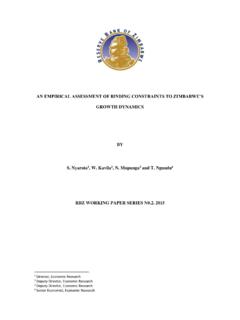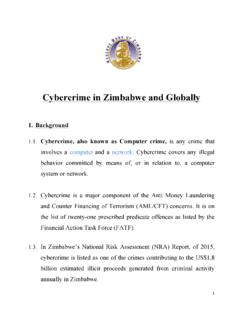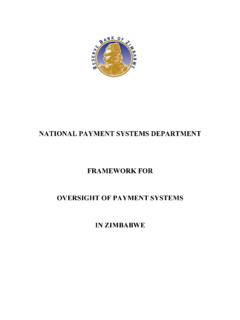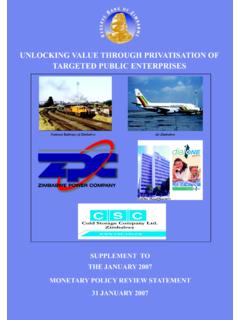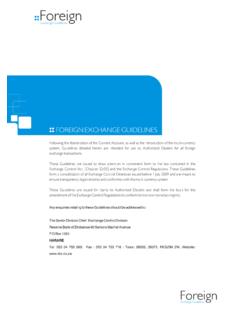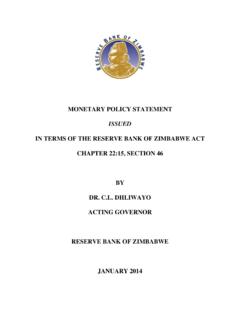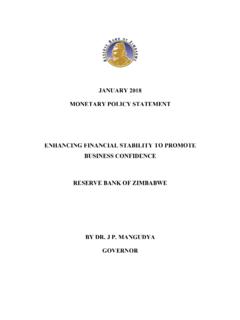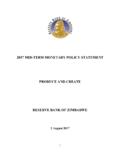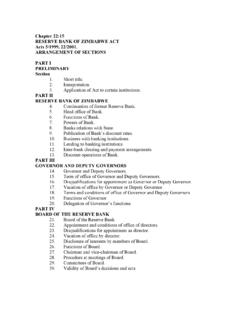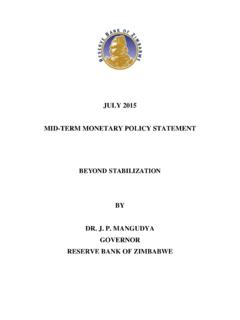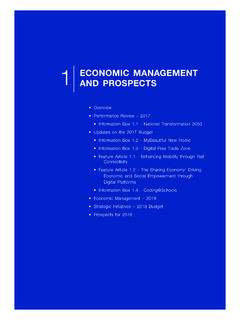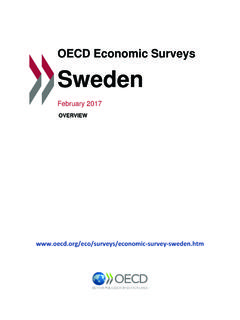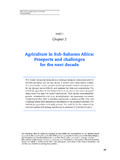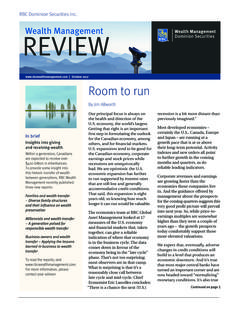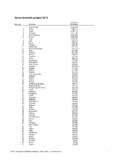Transcription of TABLE OF CONTENTS I. ACKNOWLEDGEMENTS2 …
1 TABLE OF CONTENTS . I. II. LIST OF ACRONYMS ..3. III. POLICY SCOPE AND COVERAGE ..4. 1. 2. ROLE OF THE MICROFINANCE SECTOR IN economic DEVELOPMENT AND POVERTY. ALLEVIATION ..7. Financial Inclusion ..7. Poverty Reduction and Improvement of Standards of Living ..7. Social Intermediation ..7. Microfinance and the Millennium Development Goals (MDGs) ..7. 3. RATIONALE FOR REGULATING THE MICROFINANCE SECTOR..9. 4. THE MICROFINANCE POLICY ..11. Policy Vision and Mission Statement ..11. Policy Policy Strategies ..11. Policy Values..12. 5. FRAMEWORK FOR SUPERVISION OF THE MICROFINANCE Enabling Legal and Regulatory Framework..13. Licensing and Supervision of Microfinance Banks..13. Prudential and Non-Prudential Regulation..14. Regulation of Interest Rates..15. Performance Standards and Rating Financial Inclusion Financial Inclusion Fund.
2 16. Capacity Building ..16. Credit Reference Bureau ..16. Deposit Protection Scheme ..17. Apex Associations ..17. Consumer Protection ..17. 6. ENHANCING THE PROVISION OF MICROFINANCE SERVICES ..18. Establishment of Microfinance The Goals of Microfinance Organic Growth Path For Microfinance Banks ..19. Ownership of Microfinance Banks ..19. 7 PARTICIPATION OF EXISTING FINANCIAL INSTITUTIONS IN MICROFINANCE 8. ROLES AND RESPONSIBILITIES OF KEY STAKEHOLDERS ..21. The The Reserve Bank of Zimbabwe ..21. Apex Bodies ..22. Providers of Microfinance Services ..22. Commercial Banks and Building Developmental Partners ..23. 9. POLICY INCENTIVES ..24. 10. POLICY REVIEW AND 11. CONCLUSION ..25. 1. I. ACKNOWLEDGEMENTS. The National Microfinance Policy was developed through collaborative work by the National Taskforce on Microfinance whose membership comprised Government Ministries, apex organisations of microfinance and moneylenders, microfinance institutions, development partners, and the Central Bank.
3 The Policy paper also benefited from a National Microfinance Survey, conducted by Ernst & Young, and research on international best practice. 2. II. LIST OF ACRONYMS. DPB Deposit Protection Board HIV/AIDS Human Immuno Deficiency Virus/Acquired Immuno Deficiency Syndrome MDGs Millennium Development Goals MFBs Microfinance Banks MFIs Microfinance Institutions NGOs Non-Governmental Organizations RBZ Reserve Bank of Zimbabwe SACCOs Savings and Credit Co-operative Societies SME Small to Medium Enterprises VAT Value Added Tax 3. III. POLICY SCOPE AND COVERAGE. a) The National Microfinance Policy, hereafter refered to as the policy , provides a strategic framework and roadmap for the development of a well integrated and sustainable microfinance sector in Zimbabwe.
4 B) The policy articulates the national vision, objectives, strategies and values adopted, following exhaustive consultations among all stakeholders through the National Taskforce on Microfinance, in pursuit of building an inclusive financial sector. c) The policy further outlines the framework that should be put in place to ensure appropriate supervision of the microfinance sector including minimum requirements in respect of laws and regulations; licensing and supervision of different tiers; prudential and non-prudential supervision; institutional arrangements, and the roles of various stakeholders. d) In line with international best practice in microfinance, the policy seeks to promote poverty alleviation and economic development by creating an enabling environment for the microfinance sector to blossom, while laying a strong foundation for macroeconomic stability by outlining the principles and guidelines that will promote development prospects of all stakeholders.
5 E) The policy enhances the sustained provision of diversified microfinance services to the poor which include savings, credit, money transfer, insurance and other services used to support their enterprises and economic activities as well as their household financial management and consumption needs. 4. 1. INTRODUCTION. Microfinance is generally defined as the provision of a range of financial services, including savings, small loans, insurance, and money transfer services to marginalized members of the population and SMEs that do not have access to finance from formal financial institutions. National A survey conducted by the National Task Force on Microfinance, through a consultancy firm, between December 2005 and March 2006, indicated that the formal financial system provides services to about 30% of the economically active population while the remaining 70% are excluded from access to formal financial services.
6 This 70% is often served by the informal financial sector, through microfinance institutions, moneylenders, friends, relatives, and credit unions. The survey revealed a wide range of critical issues that are discussed hereunder: a) Weak Institutional Capacity: The prolonged sub-optimal performance of many existing Savings and Credit Cooperatives Societies (SACCOS), microfinance and development finance institutions was largely attributed to incompetent management, weak internal controls and lack of a bespoke deposit protection scheme. Other factors identified include poor corporate governance, lack of well-defined operations and restrictive regulatory/supervisory requirements. b) Weak Capital Base: The existing microfinance institutions had weak capital bases which could not cannot adequately provide a cushion for the risk of lending to micro-entrepreneurs without collateral.
7 C) Existence of a Huge Un-Served Market: The size of the market unserved by existing financial institutions was large. The average banking density in Zimbabwe was one financial institution outlet to 17 000. inhabitants. In the rural areas, its was 1:63 000, that is less than 3% of rural households had access to financial services. d) Employment Generation and Poverty Reduction: The survey noted that improved access and an efficient provision of savings, credit and insurance facilities enable the poor to be self-sufficient by providing them with self employment opportunities. The micro-enterprises accessing microfinance also create employment opportunities for other people. 5. e) economic Growth and Development: Without permanent access to institutional microfinance, most poor households rely on meagre self- finance or risky and expensive informal sources of finance.
8 This would limit their ability to actively participate in and benefit from development opportunities. Microfinance institutions assist in the formalization and integration of the informal sector into the formal sector thereby facilitating economic growth and development. f) The Interest of Local and International Communities in Microfinance: Many international investors have expressed interest in investing in the microfinance sector. The establishment of a well defined microfinance framework for Zimbabwe would provide an opportunity for them to finance the economic activities of low income groups and the poor. g) Weak Regulatory Framework: Due to the diversity of institutions that provide microfinance services, coupled with a fragmented regulatory framework; regulation and supervision of the sector, hitherto had provided challenges for the regulatory authorities.
9 Policy This policy provides for the establishment of a vibrant microfinance sector that would be adequately integrated into the mainstream financial system and provide the stimulus for growth and development. It also seeks to harmonize operating standards and provide a strategic platform for the evolution of the microfinance sector, promote appropriate regulation, supervision and adoption of international best practice. The policy recognizes microfinance as a function, which can be provided by a continuum of institutions including credit only microfinance institutions, Non- Governmental Organizations (NGOs), Savings and Credit Co-operative Societies (SACCOs), microfinance banks, building societies and commercial banks. 6. 2. ROLE OF THE MICROFINANCE SECTOR IN economic DEVELOPMENT.
10 AND POVERTY ALLEVIATION. Overview In recent years, there has been increased realisation throughout the world that microfinance plays a critical role in economic development and poverty alleviation. Some of the notable benefits are briefly discussed hereunder Financial Inclusion A vibrant and sustainable microfinance sector promotes financial inclusion access to credit, savings and payment systems for all bankable people and firms, as well as access to insurance for all insurable people and firms. An inclusive financial sector therefore enables poor or low income households to access financial services and hence manage their risks better, build their assets gradually, and develop their micro- enterprises. Poverty Reduction and Improvement of Standards of Living By plugging the gap left by the mainstream financial institutions, microfinance providers improve the standards of living of the poor but economically active as well as strengthen their social and human capital.
